Benevento
Benevento (UK: /ˌbɛnəˈvɛntoʊ/,[3] US: /ˌbeɪneɪˈ-/,[4] Italian: [beneˈvɛnto] (![]()
Benevento | |
|---|---|
| Comune di Benevento | |
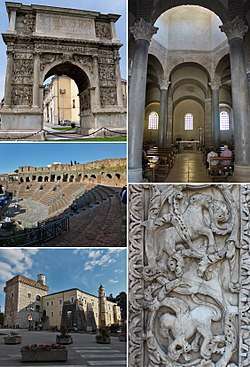 Main landmarks in Benevento. Clockwise from the upper left: the Arch of Trajan, the church of Santa Sofia, the Cathedral's main portal, the castle and the Roman theatre | |
 Flag .png) Coat of arms | |
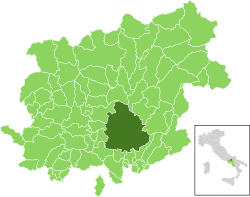 Benevento within the Province of Benevento | |
Location of Benevento 
| |
 Benevento Location of Benevento in Campania 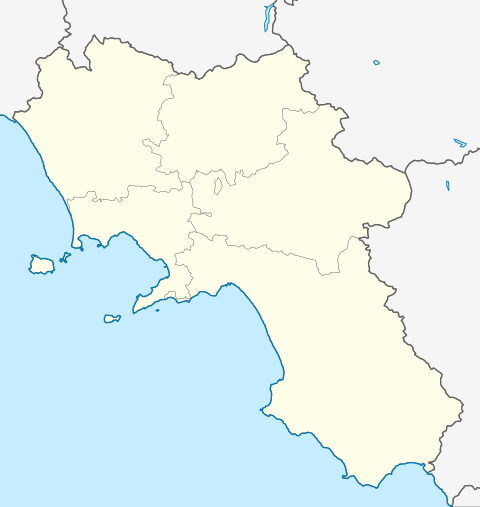 Benevento Benevento (Campania) | |
| Coordinates: 41°08′N 14°47′E | |
| Country | Italy |
| Region | Campania |
| Province | Benevento (BN) |
| Frazioni | see list |
| Government | |
| • Mayor | Clemente Mastella |
| Area | |
| • Total | 129 km2 (50 sq mi) |
| Elevation | 135 m (443 ft) |
| Population (31 August 2015)[2] | |
| • Total | 60,169 |
| • Density | 470/km2 (1,200/sq mi) |
| Demonym(s) | Beneventani |
| Time zone | UTC+1 (CET) |
| • Summer (DST) | UTC+2 (CEST) |
| Postal code | 82100 |
| Dialing code | 0824 |
| ISTAT code | 062008 |
| Patron saint | St. Bartholomew |
| Saint day | August 24 |
| Website | Official website |
Benevento occupies the site of the ancient Beneventum, originally Maleventum or even earlier Maloenton. The meaning of the name of the town is evidenced by its former Latin name, translating as good or fair wind. In the imperial period it was supposed to have been founded by Diomedes after the Trojan War.[5]
Due to its artistic and cultural significance, the Santa Sofia Church in Benevento was declared a UNESCO World Heritage Site in 2011, as part of a group of seven historic buildings inscribed as Longobards in Italy, Places of Power (568–774 A.D.).
A patron saint of Benevento is Saint Bartholomew, the Apostle, whose relics are kept there at the Cattedrale di Santa Maria Assunta.
History
![]()
![]()
![]()
![]()
![]()
![]()
![]()
![]()
![]()
![]()
![]()
![]()
Ancient era
Benevento, as Maleventum, was one of the chief cities of Samnium, situated on the Appian Way at a distance of 51 kilometres (32 mi) east from Capua on the banks of the river Calor (now Calore). There is some discrepancy as to the people to which it belonged at contact: Pliny the Elder expressly assigns it to the Hirpini; but Livy certainly seems to consider it as belonging to the Samnites proper, as distinguished from the Hirpini; and Ptolemy adopts the same view.[6] All ancient writers concur in representing it as a very ancient city; Gaius Julius Solinus and Stephanus of Byzantium ascribe its foundation to Diomedes; a legend which appears to have been adopted by the inhabitants, who, in the time of Procopius, pretended to exhibit the tusks of the Calydonian Boar in proof of their descent.[7] Sextus Pompeius Festus, on the contrary (s. v. Ausoniam), related that it was founded by Auson, a son of Ulysses and Circe; a tradition which indicates that it was an ancient Ausonian city, previous to its conquest by the Samnites. But it first appears in history as a Samnite city;[8] and must have already been a place of strength, so that the Romans did not venture to attack it during their first two wars with the Samnites. It appears, however, to have fallen into their hands during the Third Samnite War, though the exact occasion is unknown.
Benevento was certainly in the power of the Romans in 274 BC, when Pyrrhus of Epirus was defeated in a great battle, fought in its immediate neighborhood, by the consul Manius Curius Dentatus.[9] Six years later (268 BC) they further sought to secure its possession by establishing there a Roman colony with Latin rights.[10] It was at this time that it first assumed the name of Beneventum, having previously been called Maleventum, a name which the Romans regarded as of evil augury, and changed into one of a more fortunate signification.[11] It is probable that the Oscan or Samnite name was Maloeis, or Malieis (Μαλιείς in Ancient Greek), whence the form Maleventum would derive, like Agrigentum from Acragas (now Agrigento), Selinuntium from Selinus (the ruins of which are at now Selinunte), etc.[12]

.jpg)
As a Roman colony Beneventum seems to have quickly become a flourishing place; and in the Second Punic War was repeatedly occupied by Roman generals as a post of importance, on account of its proximity to Campania, and its strength as a fortress. In its immediate neighborhood were fought two of the most decisive actions of the war: the Battle of Beneventum, (214 BC), in which the Carthaginian general Hanno was defeated by Tiberius Gracchus; the other in 212 BC, when the camp of Hanno, in which he had accumulated a vast quantity of corn and other stores, was stormed and taken by the Roman consul Quintus Fulvius Flaccus.[13] And though its territory was more than once laid waste by the Carthaginians, it was still one of the eighteen Latin colonies which in 209 BCE were at once able and willing to furnish the required quota of men and money for continuing the war.[14] No mention of it occurs during the Social War, although it seems to have escaped from the calamities which at that time befell so many cities of Samnium; towards the close of the Roman Republic Benevento is described as one of the most opulent and flourishing cities of Italy.[15]
Under the Second Triumvirate its territory was portioned out by the Triumvirs to their veterans, and subsequently a fresh colony was established there by Augustus, who greatly enlarged its domain by the addition of the territory of Caudium (now Montesarchio). A third colony was settled there by Nero, at which time it assumed the title of Concordia; hence we find it bearing, in inscriptions of the reign of Septimius Severus, the titles Colonia Julia Augusta Concordia Felix Beneventum.[16] Its importance and flourishing condition under the Roman Empire is sufficiently attested by existing remains and inscriptions; it was at that period unquestionably the chief city of the Hirpini, and probably, next to Capua, the most populous and considerable city of southern Italy. For this prosperity it was doubtless indebted in part to its position on the Via Appia, just at the junction of the two principal arms or branches of that great road, the one called afterwards the Via Traiana, leading thence by Aequum Tuticum (now Ariano Irpino) into Apulia; the other by Aeclanum to Venusia (now Venosa) and Tarentum (now Taranto).[17] Its wealth is also evidenced by the quantity of coins minted by Beneventum. Horace famously notes Beneventum on his journey from Rome to Brundusium (now Brindisi).[18] It was indebted to the same circumstance for the honor of repeated visits from the emperors of Rome, among which those of Nero, Trajan, and Septimus Severus, are particularly recorded.[19]
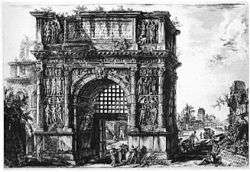
It was probably for the same reason that the triumphal arch, the Arch of Trajan, was erected there by the senate and people of Rome and constructed by the architect Apollodorus of Damascus in 114. The Arch of Trajan is one of the best-preserved Roman structures in the Campania. It repeats the formula of the Arch of Titus in the Roman Forum, with reliefs of Trajan's life and exploits of his reign. Some of the sculptures are in the British Museum. Successive emperors seem to have bestowed on the city accessions of territory, and erected, or at least given name to, various public buildings. For administrative purposes it was first included, together with the rest of the Hirpini, in the second region of Augustus, but was afterwards annexed to Campania and placed under the control of the consular of that province. Its inhabitants were included in the Stellatine tribe.[20] Beneventum retained its importance down to the close of the Empire, and though during the Gothic wars it was taken by Totila, and its walls razed to the ground, they were restored, as well as its public buildings, shortly after; and P. Diaconus speaks of it as a very wealthy city, and the capital of all the surrounding provinces.[21]
Beneventum indeed seems to have been a place of much literary cultivation; it was the birthplace of Lucius Orbilius Pupillus, who long continued to teach in his native city before he removed to Rome, and was honored with a statue by his fellow-townsmen; while existing inscriptions record similar honors paid to another grammarian, Rutilius Aelianus, as well as to orators and poets, apparently only of local celebrity.[22]
The territory of Beneventum under the Roman Empire was of very considerable extent. Towards the west it included that of Caudium, with the exception of the town itself; to the north it extended as far as the river Tamarus (now Tammaro), including the village of Pago Veiano, which, as we learn from an inscription, was anciently called Pagus Veianus; on the northeast it comprised the town of Aequum Tuticum (now Saint Eleutherio hamlet, between Ariano Irpino and Castelfranco in Miscano), and on the east and south bordered on the territories of Aeclanum (now Mirabella Eclano) and Abellinum (now Avellino). An inscription has preserved to us the names of several of the pagi or villages dependent upon Beneventum, but their sites cannot be identified.[23]
The city's most ancient coins bear the legend "Malies" or "Maliesa", which have been supposed to belong to the Samnite, or pre-Samnite, Maleventum. Coins with the legend "BENVENTOD" (an old Latin – or Samnite – form for Beneventor-um), must have been struck after it became a Latin colony.[24]
Duchy of Benevento
Not long after it had been sacked by Totila and its walls razed (545), Benevento became the seat of a powerful Lombard duchy.[5] The circumstances of the creation of duchy of Benevento are disputed. Lombards were present in southern Italy well before the complete conquest of the Po Valley: the duchy would have been founded in 576 by some soldiers led by Zotto, autonomously from the Lombard king.

Zotto's successor was Arechis I (died in 640), from the Duchy of Friuli, who captured Capua and Crotone, sacked the Byzantine Amalfi but was unable to capture Naples. After his reign the Eastern Roman Empire had only Naples, Amalfi, Gaeta, Sorrento, the tip of Calabria and the maritime cities of Apulia left in southern Italy.
In the following decades, Benevento add some territories to the Roman-Byzantine duchy by conquest, but the main enemy was now the northern Lombard Kingdom itself. King Liutprand intervened several times, imposing a candidate of his own to the duchy's succession; his successor Ratchis declared the duchies of Spoleto and Benevento foreign countries where it was forbidden to travel without royal permission.
With the collapse of the Lombard kingdom in 773, Duke Arechis II was elevated to Prince under the new empire of the Franks, in compensation for having some of his territory transferred back to the Papal States. Benevento was acclaimed by a chronicler as a "second Pavia"— Ticinum geminum— after the Lombard capital was lost. This principality was short-lived: in 851, Salerno broke off under Siconulf and, by the end of that century, Capua was independent as well. Benevento was ruled again by Byzantines between 891–895.
The so-called Langobardia minor was unified for the last time by Duke Pandolfo Testa di Ferro, who expanded his extensive control in the Mezzogiorno from his base in Benevento and Capua. Before his death (March 981), he had also gained the title of Duke of Spoleto from Emperor Otto I. However, both Benevento and Salerno rebelled to his son and heir, Pandulf II.
The first decades of the 11th century saw two more German-descended rulers in southern Italy: Henry II, conquered in 1022 both Capua and Benevento, but returned after the failed siege of Troia. Conrad II obtained similar results in 1038. In these years the three states (Benevento, Capua, and Salerno) were often engaged in local wars and disputes that favoured the rise of the Normans from mercenaries to ruler of the whole of Southern Italy. The greatest of them was Robert Guiscard, who captured Benevento in 1053 after the Emperor Henry III had first authorised its conquest in 1047 when Pandulf III and Landulf VI shut the gates to him. These princes were later expelled from the city and then recalled after the pope failed to defend it from Guiscard. The city fell to Normans in 1077. It was a papal city until after 1081.
Papal rule
Benevento passed to the Papacy peacefully when the emperor Henry III ceded it to Leo IX, in exchange for the pope's consent to the establishment of the Diocese of Bamberg (1053). Landulf II, Archbishop of Benevento, promoted reform, but also allied with the Normans. He was deposed for two years. Benevento was the cornerstone of the Papacy's temporal powers in southern Italy. The Papacy ruled it by appointed rectors, seated in a palace, and the principality continued to be a papal possession until 1806, when Napoleon granted it to his minister Talleyrand with the title of sovereign prince. Talleyrand was never to settle down and actually rule his new principality; in 1815 Benevento was returned to the papacy. It was united with Italy in 1860.[5]
Several popes personally visited Benevento. In 1128 Honorius II tried inviting Roger II of Sicily into the city in order to discuss peace terms, however, Roger refused to enter the city, for he felt unsafe within the city. Thus the two instead met on a bridge near Benevento. Only a year later, the city revolted against the Papal rule and Honorius had to beg Roger for assistance.[25]
In 1130, Anacletus II fled from Rome to the safety of Benevento after hearing that his rival, Innocent II was gaining recognition in the north.[26] When Anacletus created Roger the king of Sicily, he granted Roger the right to conscript the citizens of the city into military service, despite city itself remaining under Papal rule.[27] The declaration was not well received, as the citizens became afraid that the city was about to be annexed into the newly found kingdom. Therefore, when Roger made his move against Robert of Capua and began the civil war, Benevento sided with Robert and ousted Anacletus's supporters from the city.[28]
Manfred of Sicily lost his life in 1266 in battle with Charles of Anjou not far from the town, in the course of the Battle of Benevento.[5]
After the Italian unification
After the unification of Italy, Benevento was made provincial capital of the new Province of Benevento, comprising territories formerly belonging to the dissolved Kingdom of the Two Sicilies (Principato Ultra, Molise, Terra di Lavoro, Capitanata). In the following decades, the town saw considerable expansion and modernization; the local economy became increasingly diversified, with the traditional agricultural sector (especially the cultivation of tobacco and cereals) being joined by growing confectionery, mechanical, liquor, lumber and brickmaking industries.
During World War II, Benevento's key position in the railway communications between Rome and Apulia resulted in the town being heavily bombed by the Allied air forces in the summer of 1943. These raids caused 2,000 deaths and left 18,000 homeless out of a population of 40,000, and resulted in the destruction of half of the town.[29][30][31][32] The railway and industrial districts were hit the hardest, but the old city centre also suffered heavily; the Cathedral was almost completely destroyed, and its reconstruction was only completed in the 1960s.[33][34][35] After being briefly occupied by the Germans in the wake of the Armistice of Cassibile, Benevento was liberated by the Allies on 2 October 1943.
Four years after the war, on 2 October 1949, Benevento was hit hard by a flood of the Calore Irpino.
During the 1950s Benevento was mainly ruled by Monarchist or MSI mayors, and then for three decades (until the 1990s) by the Christian Democracy. Public sector grew considerably during this period, becoming a prime source of employment for many inhabitants of the province; the town also saw increasing demographic expansion, resulting in a somewhat incontrolled building boom. In recent years, several urban renewal projects have been carried out in the old city centre, and Benevento has become the seat of the University of Sannio and several research institutes.
Jewish history
Epigraphical evidence show that a Jewish community had existed in Benevento since the fifth century at least.[36][37] At the 10th century, Jewish traveller Ahimaaz ben Paltiel describes in his chronicle the Jewish community of Benevento, among other southern Italy towns.[38] One of his relatives established a Yeshiva in town and a large part of his family ended residing in Benevento.[39] In 1065, prince Landulf IV of Benevento forced a number of Jews to convert to Christianity. He was reproved for doing that by Pope Alexander II.[40] When Jewish traveller Benjamin of Tudela visited Benevento in 1159 or 1165, he described 200 Jewish families living in it.[41][42] Being under Papal rule (unlike the rest of southern Italy), the Jewish community of Benevento was not expelled, as most other southern Italy Jewish communities in 1541.[36] Nevertheless, they were expelled from town later on 1569, under Pope Paul IV.[36] In 1617 the Jewish community was given permission to settle back in town, though 13 years later they were expelled once again after being accused of Well poisoning.[36] Since then, there was no organized Jewish community in Benevento.[43] Nevertheless, Jews had lived in Benevento in an unorganized manner during the past centuries, in addition to a few Israeli Jews living in town in recent years, occasionally suffering of Anti-Semitic incidents.[44][45]
Main sights
Ancient remains

The importance of Benevento in classical times is vouched for by the many remains of antiquity which it possesses, of which the most famous is the triumphal arch erected in honour of Trajan by the senate and people of Rome in 114, with important reliefs relating to its history. Enclosed in the walls, this construction marked the entrance in Benevento of the Via Traiana, the road built by the Spanish emperor to shorten the path from Rome to Brindisi. The reliefs show the civil and military deeds of Trajan. A great part of the arch is decorated with scenes in bas relief: particularly the pillars directed to the town represent scenes of peace and military scenes. The height of the monument is of 15,60 meter, with an arch of 8 meter, a structure composed of limestone rocks and a marble covering. The arch was put during the Middle Age in the fenced area of the town, in order to represent the Porta Aurea.
There are other considerable remains from ancient era:
- The well-preserved ancient theatre, next to the Cathedral and the Port'Arsa gate. This grandiose building was erected by Hadrian, and later expanded by Caracalla. It is a testimony of the presence of different Hellenic tendencies, in opposition to the previous art of Traiano. The theater, oriented toward the Taburno, has a diameter of 90 meters and could house up to 10,000 spectators; it was covered with polychrome marble decorated with plaster and mosaics. During the XVIII century on one extremity of the hemicycle was built the church of Santa Maria della Verità. The archaeologist Almerico Meomartini at the end of the 19th century promised the restoration but the works ended only in 1957; from that moment the theater is used for theater, dance, and opera performances. But has been lost a part of the marble cover; until today have survived the cavea, the scenery and the first two arches.
- A large cryptoporticus 60 m long, known as the ruins of Santi Quaranta, and probably an emporium. According to Meomartini, the portion preserved is only a fraction of the whole, which once measured 520 m in length.
- A brick arch called Arco del Sacramento.
- The Ponte Leproso, a bridge on the Via Appia over the Sabato river, below the city center.
- Thermae along the road to Avellino.
- The Bue Apis, popularly known as Aufara ("buffalo"). It is a basement in the shape of an ox or bull coming from the Temple of Isis.
Many inscriptions and ancient fragments may be seen built into the old houses. In 1903 the foundations of the Temple of Isis were discovered close to the Arch of Trajan, and many fragments of fine sculptures in both the Egyptian and the Greco-Roman style belonging to it were found. They had apparently been used as the foundation of a portion of the city wall, reconstructed in 663 under the fear of an attack by the Byzantine emperor Constans II, the temple having been destroyed by order of the bishop, St Barbatus, to provide the necessary material (A. Meomartini, 0. Marucchi and L. Savignoni in Notizie degli Scavi, 1904, 107 sqq.).
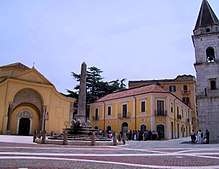
Santa Sofia
The church of Santa Sofia is a circular Lombard edifice dating to c. 760, now modernized, of small proportions, and is one of the main examples of religious Lombard architecture. The plan consists of a central hexagon with, at each vertex, columns taken from the temple of Isis; these are connected by arches which support the cupola. The inner hexagon is in turn enclosed in a decagonal ring with eight white limestone pillars and two columns next to the entrance. The church has a fine cloister of the 12th century, constructed in part of fragments of earlier buildings. [5] This cloister today is the location of the Museo del Sannio. The church interior was once totally frescoed by Byzantine artists: fragments of these paintings, portraying the Histories of Christ, can be still seen in the two side apses.
Santa Sofia was almost destroyed by the earthquake of 1688, and rebuilt in Baroque forms by commission of the then cardinal Orsini of Benevento (later Pope Benedict XIII). The original forms were hidden, and were recovered only after the discussed restoration of 1951.
In 2011, it became a UNESCO World Heritage Site as part of a group of seven inscribed as Longobards in Italy, Places of Power (568-774 A.D.).

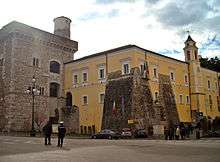
The Cathedral
The Cathedral of Santa Maria Assunta, with its arcaded façade and incomplete square campanile (begun in 1279 by the archbishop Romano Capodiferro) dates from the 9th century.[5] It was rebuilt in 1114, the façade inspired by the Pisan Gothic style. Its bronze doors, adorned with bas-reliefs, are notable example of Romanesque art which may belong to the beginning of the 13th century. The interior is in the form of a basilica, the double aisles carried on ancient columns. There are ambones resting on columns supported by lions, and decorated with reliefs and coloured marble mosaic, and a candelabrum of 1311.[5] A marble statue of the apostle San Bartolomeo, by Nicola da Monteforte, is also from the 14th century. The cathedral also contains a statue of St. Giuseppe Moscati, a native of the area. The cathedral was completely destroyed in 1943 because of bombardments: what remained of the cathedral were just the bell tower, the façade and the crypt. Another testimony of the cathedral is the XII century bronze door, the Janua Major, composed of 72 tiles with bas relief, whose fragments were rebuilt after the Second World War. The current monument, with its modern aspect, was completed in 1965 and restored between 2005 and 2012.
Rocca dei Rettori
The castle of Benevento, best known as Rocca dei Rettori or Rocca di Manfredi, stands at the highest point of the town, commanding the valley of the rivers Sabato and Calore, and the two main ancient roads Via Appia and Via Traiana. The site had been already used by the Samnites, who had constructed here a set of defensive terraces, and the Romans, with a thermal plant (Castellum aquae), whose remains can be still seen in the castle garden. The Benedictines had a monastery there. It received the current name in the Middle Ages, when it became the seat of the Papal governors, the Rettori.
The castle is in fact made by two distinct edifices: the Torrione ("Big Tower"), which was built by the Lombards starting from 871, and the Palazzo dei Governatori, built by the Popes from 1320.
Other sights
- The Roman theatre (2nd century).
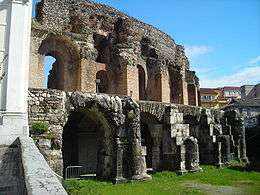 The Roman theatre.
The Roman theatre. - Sant'Ilario, not far from the Arch of Traian along the first trait of the Via Traiana, is a very ancient, small building dating from the end of the 6th or the beginning of the 7th century.
- The Palazzo di Paolo V (16th century).
- The church of San Salvatore, dating from the High Middle Ages.
- The Gothic church of San Francesco alla Dogana.
- The Baroque churches of Annunziata, San Bartolomeo and San Filippo.
Territorial subdivisions
Frazioni, or wards, include: Acquafredda, Cancelleria, Capodimonte, Caprarella, Cardoncielli, Cardoni, Cellarulo, Chiumiento, Ciancelle, Ciofani, Cretazzo, Epitaffio, Francavilla, Gran Potenza, Imperatore, Lammia, Madonna della Salute, Masseria del Ponte, Masseria La Vipera, Mascambruni, Montecalvo, Olivola, Pacevecchia, Pamparuottolo, Pantano, Perrottiello, Piano Cappelle, Pino, Ponte Corvo, Rosetiello, Ripa Zecca, Roseto, Santa Clementina, San Chirico, San Cumano (anc. Nuceriola), San Domenico, San Giovanni a Caprara, Sant'Angelo a Piesco, San Vitale, Scafa, Serretelle, Sponsilli, Torre Alfieri, and Vallereccia .
Economy
The economy of Benvento area is traditionally agricultural. Main products include vine, olives and tobacco. The main industry is that of food processing (sweets and pasta), although textile, mechanics and construction companies are present.
Sports
The Stadio Ciro Vigorito is a multi-use stadium in Benevento, which is mostly used as the home venue of Serie B side Benevento Calcio.
Transportation
Benvento is connected to Naples through the modern SS7 Appia state road, and then local roads starting from Arienzo. It is 17 kilometres (11 miles) from the Naples-Bari A16 motorway. The SS372 Telesina state road allows reaching the A1 Naples-Rome, leading to the latter in less than three hours.
Benevento railway station, on the Caserta-Foggia railway, has fast connections from Rome to Avellino, Bari and Lecce. Trains to Campobasso have been mostly replaced by bus services. The connection to Naples is ensured by three stations on the MetroCampania NordEst inter-urban metro line.
Airports
The nearest airports are:
- Salerno-Pontecagnano (QSR) 89 km
- Napoli-Capodichino (NAP) 91 km
People
- Saint Giuseppe Moscati, a doctor, was born here in 1880, the first modern physician designated a saint by the Catholic Church
- Januarius, Bishop of Naples, is a martyr saint of the Roman Catholic and the Eastern Orthodox Churches. While no contemporary sources on his life are preserved, later sources and legends claim that he died during the Diocletianic Persecution,[2] which ended with Diocletian's retirement in 305.Januarius is the patron saint of Naples, where the faithful gather three times a year in Naples Cathedral to witness the alleged liquefaction of what is claimed to be a sample of his blood kept in a sealed glass ampoule.
- Immanuel Ben Jekuthiel of Benevento, a Jewish grammarian and corrector of the press of Mantua in the 16th century. He was the author of the Jewish textbook Liwyat Hen (1557, Mantua).[46]
- Antonio Sancho de Benevento, a silversmith artist of the Spanish Renaissance and monk of the Monastery of Sant Jeroni de Cotalba, near Gandia (Valencia) in Spain
- Carlotta Nobile, Art historian, violinist, blogger and Art Director of Santa Sophia Academy chamber Orchestra in Benevento from September 2010 up to her death at the age of 24.
See also
References
- "Superficie di Comuni Province e Regioni italiane al 9 ottobre 2011". Istat. Retrieved 16 March 2019.
- "Popolazione Residente al 1° Gennaio 2018". Istat. Retrieved 16 March 2019.
- "Benevento". Collins English Dictionary. HarperCollins. Retrieved 30 May 2019.
- "Benevento". Merriam-Webster Dictionary. Retrieved 30 May 2019.
-

- Pliny iii. 11. s. 16; Livy xxii. 13; Ptolemy iii. 1. § 67.
- Gaius Julius Solinus 2. § 10; Steph. B. s. v.; Procop. B. G. i. 15.
- Livy ix. 27.
- Plutarch Pyrrh. 25; Frontinus Strategemata iv. 1. § 14.
- Livy Epit. xv.; Velleius Paterculus i. 14.
- Pliny iii. 11. s. 16; Liv. ix. 27; Fest. s. v. Beneventum, p. 34; Steph. B. s. v.; Procop. B. G. i. 15.
- James Millingen, Numnismatique de l'Italie, p. 223.
- Liv. xxii. 13, xxiv. 14, 16, xxv. 13, 14, 15, 17; Appian, Annib. 36, 37.
- Livy xxvii. 10.
- Appian, B.C. iv. 3; Strabo v. p. 250; Cicero In Verrem i. 1. 5.
- Appian. l. c.; Lib. Colon. pp. 231, 232; Inscr. ap. Romanelli, vol. ii. pp. 382, 384; Orell. Inscr. 128, 590.
- Strabo vi. p. 283.
- Sat. i. 5, 71.
- Tacitus Ann. xv. 34.
- Pliny iii. 11. s. 16; Mommsen, Topogr. degli Irpini, p. 167, in Bull. dell'Inst. Arch. 1847.
- Procop. B. G. iii. 6; P. Diac. ii. 20; De Vita, Antiq. Benev. pp. 271, 286.
- Suet. Gram. 9; Orell. Inscr. 1178, 1185.
- Henzen, Tab. Aliment. Baebian, p. 93-108; Mommsen, Topogr. degli Irpini, p. 168-71.
- Millingen, Numismatique de l'Anc. Italie, p. 223; Friedländer, Osk. Münz. p. 67; McClure, British Place-Names etc., p. 33.
- Matthew, Donald (1992). The Norman Kingdom of Sicily. Cambridge University Press. p. 32. ISBN 9780521269117.
- Matthew, Donald (1992). The Norman Kingdom of Sicily. Cambridge University Press. pp. 34–35. ISBN 9780521269117.
- Matthew, Donald (1992). The Norman Kingdom of Sicily. Cambridge University Press. pp. 36–37. ISBN 9780521269117.
- Matthew, Donald (1992). The Norman Kingdom of Sicily. Cambridge University Press. pp. 42–43. ISBN 9780521269117.
- Il Sannio sotto le bombe. Le incursioni aeree sulla provincia di Benevento durante la Seconda guerra mondiale
- "Benevento 1943", una mostra sui bombardamenti che colpirono Benevento
- Benevento '43
- A Benevento un’area intitolata alle 2mila vittime dei bombardamenti americani del ’43
- Gazzetta di Benevento
- Bombe su Benevento, gli orrori del settembre 1943
- I bombardamenti su Benevento nel 1943 in cinque fotografie aeree dei "National Archives" di Washington in: Samnium LXXIX (2006), S. 229 - 243.
- https://www.jewishvirtuallibrary.org/jsource/judaica/ejud_0002_0003_0_02457.html
- http://www.byzantinejewry.net/applications/mjcb/show_evidence_details.php?evidence_id=287
- Ahimaaz ben Paltiel
- Bonfil, Robert (2009). History and Folklore in a Medieval Jewish Chronicle. Leiden: Brill. p. 74. ISBN 978-90-04-17385-9.
- http://bnmal.it/sito/2013/06/ebrei-a-benevento-dal-ix-al-xvi-secolo/
- http://jewishencyclopedia.com/articles/2939-benevento
- Patai, Jennifer (1989). The Myth of the Jewish Race. Detroit: Wayne State University Press. p. 44. ISBN 0-8143-1948-3.
- Encyclopaedia Judaica: Ba-Blo, p. 341, at Google Books
- http://antisemitism.org.il/article/83571/swastikas-were-painted-store-ancient-city-benevento
- http://www.ntr24.tv/it/news/cronaca/benevento-via-iii-settembre-svastiche-su-un-negozio-del-centro-storico.html
- http://jewishencyclopedia.com/articles/8088-immanuel-ben-jekuthiel-of-benevento
Sources

- von Falkenhausen, Vera (1983). "I Longobardi meridionali". In Giuseppe Galasso (ed.). Il Mezzogiorno dai Bizantini a Federico II. Turin: UTET. pp. 251–364.
- Cilento, Nicola (1971). Italia meridionale longobarda. Milan-Naples: Ricciardi.
External links
| Wikimedia Commons has media related to Benevento. |
- The History Files: Independent Dukes (571–774) and Princes (774–1053) of Benevento
- Beneventan liturgical chant, c. 650 – c. 800
- Pictures from Benevento
- Photo Gallery by Leonardo Bellotti (in Italian)